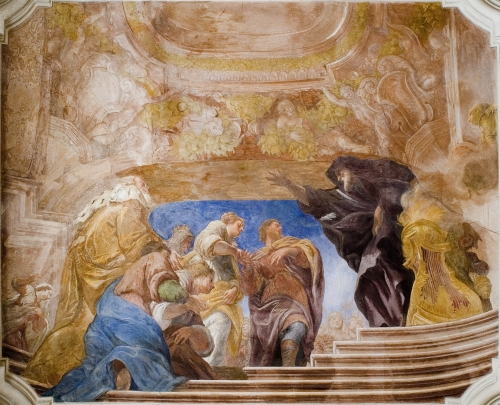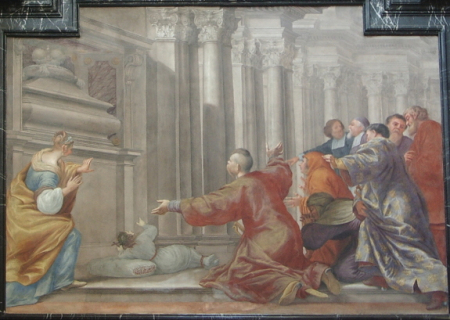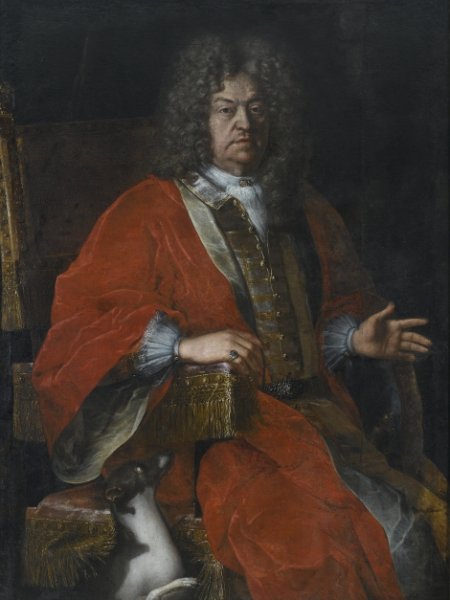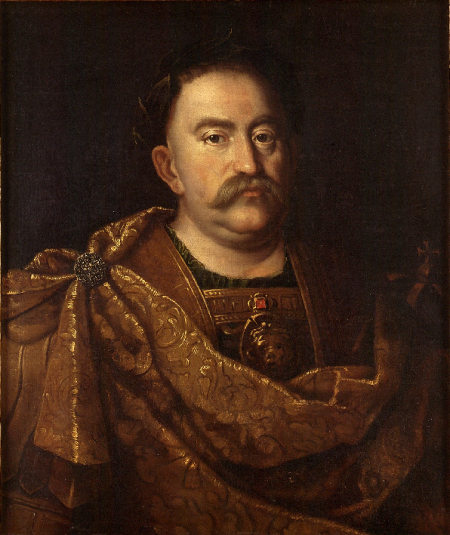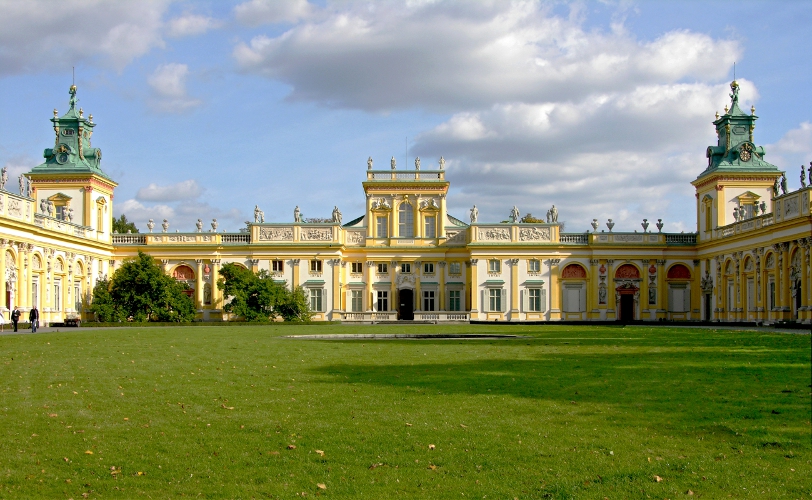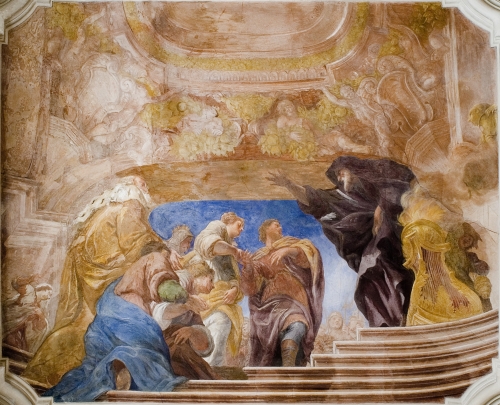Born in Campi, near Florence, on the day of Saint Michael the Archangel, 29 September 1642, Michele Arcangelo (Michelangelo) Palloni undoubtedly figures among the most accomplished artists of the era of Jan III, and was also one of a number of Italians employed in the historic territories of Poland. For his contemporaries, he was a ‘famous painter’, the kind one would send one’s own caroche for and lavishly remunerate; lexicographers, on the other hand, consistently noted the artistic values of his frescoes and canvasses. In the nineteenth century, probably due to an erroneous interpretation of a blurred signature, a part of his oeuvre was mistakenly ascribed to a non-existent ‘Del Bene’. Today, much more is known about the restless and toilsome life of the Tuscan painter who opted to try his luck in the far-off Commonwealth. In spite of the ravages of war and dearth of archival information — but also against the artist’s tendency to leave his works unsigned — Palloni’s varied artistic output is known and understood better today than it had been in the past. More is known of the painter’s Florentine period and his ties to the Medici court. New hypotheses emerged, too, with regard to his artistic education and oeuvre. Conservation efforts of the past few years, on the other hand, revealed the secrets of Palloni’s style, bringing the lustre back to many a masterpiece hidden under a blanket of three hundred years’ worth of dust and attempts at repainting which damaging the image of the artist. Employed by esteemed patrons who understood art, the Italian painter exhibited a singular painterly erudition, quite distinct from that exhibited by Polish royal artists trained in Italy — Jerzy Szymonowicz-Siemiginowski or Jan Reisner. Palloni adapted the artistic achievements of seventeenth century Italy — particularly Florence — to the sensibilities of the royal court, the magnates of the eastern borderlands (Kresy), monastic or popular religiosity, demonstrating an uncommon dexterity of touch and ingenuity in designs for future compositions and interpretations of known iconographic themes even at the latest stage of his career. This dexterity, coupled with an ease of applying the artistic approach best suited to the demands of the place and purpose of his decorations, had incidentally caused a considerable amount of trouble to historians of art, sowing doubts about authorship or hypotheses concerning cooperation with other painters. Today, the secrets of Palloni’s technique and style are attributed to his Florentine education.
Palloni arrived to the Commonwealth as a fully developed artist registered in infrequent signatures as Florentinus (Florentine). The variety which typifies his works stemmed from the particular history of Florentine painting, developing in obedience to Tuscan traditions under the patronage of the Medici court and the influence of notable guests, such as Justus Sustermans, a Dutch portrait painter who taught the impasto technique to local painters, or Jacques Callot, an admirer of grotesque engravings. During childhood and youth, Palloni was drawn to the Florentine works of the followers of Caravaggio, which had also influenced the mysticism of Carlo Dolci. Their sombre style found favour with Palloni’s friends, painters Pier Dandini and Anton Domenico Gabbiani, among others. Other Florentine artists were fascinated by Roman Classicism, like Palloni’s teacher since about 1655, the frescoist and easel painter Baldassarre Franceschini, known as ‘Il Volterrano’. A major representative of this current was the frescoist Pietro da Cortona, who also worked in Florence. Franceschini introduced Palloni to the arcana of both fresco and oil painting. Traces of this education, followed by a close cooperation with the master (Palloni likely contributed to the fresco at the Niccolini Chapel in the church of Santa Croce, 1655–61, and to decorations at the church of Saint Maria Maddalena de’ Pazzi, 1669), remained in evidence until the end of the painter’s artistic career, for instance in the colours he favoured (shades of rose and violet), the way he shaped draperies, and the physiognomic types of his figures. Franchescini inculcated in Palloni a respect for the modern decorative art of Pietro da Cortona as well as the Florentine tradition of fresco painting derived from the art of sixteenth-century Venetian painters or Correggio. Palloni’s earliest independent work was probably the fresco for the altar at the church of San Lorenzo in his native Campi: Madonna with Saint John and Saint Hieronymus under the Cross (dated to the turn of 1650s and 1660s). We can only imagine the warm welcome the local population would have offered to an accomplished work by the son of Cosimo di Fiorindo Palloni and Maria Maddalena Palloni, as well as the cousin of the local preacher, Rev. Andrea di Fiorindo Palloni.
After many years of training under Franceschini, Michelangelo of Campi began to receive commissions from Cosimo III de’ Medici in 1671. In 1673 he enrolled in the Florentine Academy of Drawing (Accademia del Disegno), becoming a member three years later. During that period, he undoubtedly mastered the scientific foundations of fresco painting, for instance, the rules of perspective which allowed him to render truthfully scenes taking place in an architectonic scenery viewed from different angles (quadratura), or figures viewed from below in a drastic foreshortening (di sotto in sù). It is assumed that Palloni subsequently received education in Rome (ca. 1673–6) in the so-called Florentine School (Scuola Fiorentina), tutored by the renowned frescoist and easel painter Ciro Ferri. The influence of Cortona, illusionism, and monumentalism, evidenced in his works, clearly testify to his knowledge of the art of Rome. Recently found archival documents speak of his activities in Florence. In 1674–6 Palloni accepted orders from the Medici tapestry factory (Arazzeria Medicea). He prepared patterns for fabric compositions (so-called cartoons), adapting works of sixteenth-century Florentine artists (e.g. Francesco Salviati, Andrea del Sarto), among others. Tapestries remaining in the Medici collections — The Golden Age, based on the work of Pietro da Cortona, and a portrait of Cosimo III de’ Medici — testify to Palloni’s talents as a copyist and portraitist in the absence of the missing originals. In Florence, Palloni was offered an opportunity to acquaint himself with the basic tendencies in Italian painting while adopting the features typifying the art of his home base. The ability to observe masterpieces of ancient art and the works of outstanding artists of the seventeenth century proved crucial during the Polish phase of his career, since the painter had willingly and tastefully borrowed from compositions of Venetian or Roman masters, imitating their settings and monumental narratives. The Roman tradition is captured in antiquated details and compositions that go hand in hand with the Florentine taste for faithfully replicated musculature of athletic figures. His employment as a cartoonist had doubtless contributed to Palloni’s sense for tasteful details and finely textured fabrics, a feature peculiar to his artistic home. A penchant for combining patterned clothes with striking poses and gestures of the painted figures became staples of his art. The recurrent anti-Classicism of his works, present in the Mannerism of the elongated figures and the grotesque facial expressions, also speaks to his artistic roots.
The circumstances of Palloni’s arrival to the Commonwealth are unknown. According to sources found in Florence, he is thought to have set out for Poland in the latter half of 1676. Until 1684, he was a protégé of Krzysztof Zygmunt Pac, painting frescoes in the Camaldolese church at Pažaislis founded by the Grand Chancellor of Lithuania (1676–84) and in the nave of the church of Saint Peter and Saint Paul at Antakalnis (1685–6), erected by Grand Hetman of Lithuania Michał Kazimierz Pac, who maintained ties to the Medici court. Though Palloni returned to Vilnius to decorate the Chapel of Saint Casimir at the cathedral (ca. 1690–2) and the palaces of the Słuszka (1690–4) and Sapieha (1691–7) families, archival documents in Lithuania indicate that he and his wife, Anna Maria née Lanzani, had eventually left Pažaislis—the place of birth of two of their children, Melchior and Róża — in 1686. In 1688, already in his capacity as royal painter, he acquired a house in Warsaw’s Leszno district. The move to the capital was sparked by the finding of a new patron — the Voivode of Płock Jan Dobrogost Krasiński, for whom Palloni prepared decorations for the vestibule and plafonds at the Krasiński Palace (ca. 1684–5), which did not survive to our times.
Palloni arrived to Warsaw as a renowned artist. His Lithuanian oeuvre clearly illustrates the blossoming talents of a painter seeking to dazzle his Slavic audiences with the richness and variety of figural compositions captured from different perspectives, set in impeccably composed monumental architecture. The scenes he painted took place against radiant skies, among fabrics draped in a sculpture-like manner and delicately drawn landscapes animated by hints of light and shadow. In works which survived to our times, features characteristic for the wall paintings of the artist from Campi coexist in perfect harmony: dynamic poses and gestures, expressive mimics and narration, developed artfully or highlighted through realist detail.
The move to Warsaw and commissions from the King and magnates solidified the professional and economical standing of the painter. Jan III employed Palloni to prepare decorations for the Wilanów Palace: the grotto, located in the underpinning of the garden terrace (1686), and the galleries. While little is known of the former, the placement of the paintings suggests that the frescoes it included depicted shepherds or mythic creatures in a contrasted light-and-shadow scenery. Similar figures recur in the galleries, adorned with a series of frescoes depicting the Story of Psyche (Historia Panny Psyche, after 1688), in which, on the basis of Apuleius’ The Golden Ass, the painter recounted the tragic story of the love of Psyche and Amor. The paintings alluded to the relationship between Jan Sobieski and Marie Casimire while subscribing to the general conceptual program of the Wilanów residence — an allegorical journey of a soul to the land of eternal bliss. The remains of the cycle in the North Gallery and the frescoes in the South Gallery, radically repainted in the eighteenth and nineteenth centuries, mainly serve to highlight the major compositional virtues of the decorations. In his work, Palloni followed the classicising design of the Wilanów interiors, benefiting to some extent from sixteenth-century etchings of the Master with Dice, based on Michiel Coxcie’s copies of Raffael’s designs, which were also employed in the following century by other authors of cycles of tapestries devoted to Psyche (Sébastien François de la Planche, 1650; Jan van Orley, ca. 1685).
Working hand in hand with younger colleagues educated at the Academy of Saint Luke in Rome — Szymonowicz and Reisner — Palloni came to draw more from Roman style and colouring. The decorations at Wilanów astound with the variety of figural settings and architectural illusions and fictive landscapes breaking the monotony of the communicative sequence. Frescoes optically enlarged the interiors through contrasting colours and the coulisse effect of figures in a gradation of sizes. The monumental quadratura imparted splendour on the royal residence, while frescoes on the gallery walls warmed them up like tapestries, opening the perspective on the adjacent garden. The defected and repainted works depicting the travels of Odysseus and Aeneas, which decorate the galleries of the Palace from the outside, are also sometimes attributed to Palloni, but seem too static and bound up with their graphical prototypes (such as Giuseppe Mitelli’s collection of engravings based on A. Carracci’s designs for the Palazzo Fava in Bologna, dedicated to Leopoldo de’ Medici; see: L’Enea vagante, Roma: G.J. de Rossi, 1663) to be attributed to the ambitious Florentine frescoist. The royal painter had, after all, proven the quality of his craft both in minor works commissioned by monastic orders (e.g. frescoes in the sacristy of the Camaldolese church in the Warsaw suburb of Bielany, ca. 1684–96; frescoes in the refectory of the monastery of the Discalced Carmelites in Warsaw, 1702) and in prestigious projects executed for magnates: decorations in the apartments of Leszczyńskis’ Rydzyna Castle (ca. 1688–92, destroyed) or the aforementioned Chapel of Saint Casimir in Vilnius.
Among the best of Palloni’s works are paintings in the Chapel of Saint Charles Borromeo in the collegiate church in Łowicz, commissioned by Primate Michał Stefan Radziejowski (ca. 1690–5). In his decorations, Palloni applied Gianlorenzo Bernini’s principle of integrating interiors by combining frescoes with illusionist stuccoes. His works at Łowicz corroborate the claim that the artist had travelled to Italy between 1685 and 1688, since he clearly drew inspiration from the interior decorations of the Il Gesù church in Rome, the work of Bernini and Giovanni Battista Gaulli (Baciccio). Later works of the Florentine artist — particularly the frescoes at the parish church (ca. 1706–8) and reformed church (after 1709) in Węgrów — testify to developments in Palloni’s output spurred by new tendencies in decorative art. Documenting the evolution of the Baroque art of the fresco, the Tuscan painter’s works continued to reflect the local colour and customs of the Polish society. The Florentine mores and approach of the frescoist have also remained unchanged. Frescoes (made in the buon fresco technique) were produced quickly with a narrow selection of pigments. The painter drew the composition on freshly laid plaster, first impressing the contours of the cartoon, then daubing a sketch with thin red paint, highlighting the shades, and finally placing the colours with paints mixed with lime. At the same time, he used lime as the colour white and to mark light to the shadows. The compositions were perfected on dry plaster (al secco).
The poor current shape of most of Palloni’s fresco compositions does not express the mastery of the original works. However, it can be appreciated thanks to canvasses attributed to him, since Palloni produced religious canvasses and portraits in oil during his time of employment as frescoist. Aside from the poorly maintained early works from the church of the Augustians in Vilnius (Sacrifice at the Temple and Christ among the Doctors, currently at Lietuvos dailės muziejus in Vilnius) and the Camaldolese temple at Pažaislis (Crucifixion, ca. 1677–85), three other half-length portrayals of Christ are ascribed to Palloni. The painting of Christ on the Cross found in Częstochowa (at the Museum of the Archdiocese of Częstochowa) is the nearest approximation of the one at Pažaislis. During his tenure as King Jan III’s painter, Palloni also authored a canvas depicting Christ pointing to the wound in his side; it is inscribed with the royal insignia and the legend ‘Ex aula Ser[enissimi] Ioan[nis] R[egis] Pol[oniae]’ (From the Court of His Serene Highness Jan III the King of Poland), currently at the church of Our Lady in Toruń. It has been attached to the altar at Toruń thanks to the former Royal Secretary Jan Kazimierz Rubinkowski, who probably acquired the work from the family members of an acquaintance of Palloni’s, Bartolomeo Sardi, Postmaster General of the Crown and secretary to Queen Marie Casimire. The third picture of Christ attributed to Palloni is found at the parish church in Piekoszów, near Kielce (early eighteenth century). Associated with the patronage of the Tarło family, the picture achieved the rank of a sacred painting. These mystic portrayals of the Saviour approximated the style of religious painting found at the Medici court, and were directly inspired by Franceschini’s Ecce Homo, extant in several variants. However, Palloni endowed it with features of his own stylistic approach by combining the meticulously formed muscles with Christ’s expressive face. In his religious paintings, the Florentine invoked Tuscan lyricism (Saint Anthony, ca. 1702, Visitation monastery in Warsaw), but also employed a palette of colours analogous to those he used in his frescoes — a fact proved by the grand-scale painting of the Holy Trinity (before 1695) at the church of Saint Nicholas at Leszno, attributed to Palloni.
Palloni painted portraits throughout his stay in Poland, contributing to the rise in popularity of the full portraits. Among works attributed to the Italian are portraits of Primate Michał Stefan Radziejowski (ca. 1696, Museum in Nieborów and Arkadia) and the enormous canvasses depicting Jan Dobrogost Krasiński and Aleksander Wyhowski, Bishop of Łuck (ca. 1712, parish church at Węgrów). Palloni’s portrait art is characterised by the use of chiaroscuro for modelling complexions, expression of faces and hands, and jewellery or textile detailing; this is clearly evident in the half-length portraits of Krasiński — with the subject seated in an armchair (Museum of King Jan III’ Palace at Wilanów) and standing upright in an armour (early eighteenth century, National Museum in Kielce). Palloni’s brushwork seems to be in evidence in one of the most accomplished portraits of Jan III in a laurel wreath (Museum of King Jan III’s Palace at Wilanów, inventory no. Wil. 1348). The colouration, facial modelling, and positioning of the light that typify the Italian’s canvasses reflect his early experiences as a copyist, while the lining of the draped patterned cloak, a feature found in his works on plaster, betrayed the manner of a frescoist. It can be assumed that relations with the court of Jan III brought on other thus far unattributed portraits and historical paintings. The pictorial record only speaks of a lost painting from the Nesvizh gallery, portraying the confirmation of the Radziwiłł family’s ducal title at the Sejm in Piotrków.
After Jan III’s demise, the ageing artist left Warsaw. He sold his house in 1696 and, like Reisner, moved into Krasiński’s estate along with his family (1705). The fact that his children married members of other Italian families testifies to animated relations with his nationals in Vilnius and Warsaw. Sadly, the artistic output of Palloni’s son is unknown, as is that of the possible students or followers of the Tuscan painter, whose hard-working and productive life ended in Węgrów between 26 May 1711 and 17 December 1713.
Secondary Sources (selection):
U. (Bieszczad) Bauman, ‘Nieznany obraz Michelangela Palloniego z kościoła św. Mikołaja w Lesznie’, Wielkopolski Biuletyn Konserwatorski 2 (2003), pp. 24–45.
A.S. Czyż, Kościół świętych Piotra i Pawła na Antokolu w Wilnie, Wrocław 2008.
S. Fiedorczuk, ‘Prace konserwatorskie fresków Michelangela Palloniego w farze węgrowskiej’, Rocznik Mazowieckiego Konserwatora Zabytków 1 (2006), pp. 71–83.
M. Górska, ‘Wizerunki Chrystusa pędzla Michelangela Palloniego’, Ikonotheka 18 (2005), pp. 51–69.
G. M. Guidetti, ‘Novità e precisazioni sulla formazione artistica di Michele Arcangelo Palloni’, in: Artyści włoscy w Polsce XV–XVIII wiek, ed. J. A. Chrościcki and R. Sulewska, Warszawa 2004, pp. 264–292.
G.M. Guidetti, ‘Additional information about the sources of Michele Arcangelo Palloni’s artistic language’, Acta Academiae Artium Vilnensis 51 (2008), pp. 75–89.
M. Heydel, ‘Palloni Michael Archangelo’, in: Słownik artystów polskich i obcych w Polsce działających. Malarze, rzeźbiarze, graficy, vol. 6, ed. K. Mikocka-Rachubowa and M. Biernacka, Warszawa 1998, pp. 400–405.
M. Karpowicz, Cuda Węgrowa, Węgrów 2009.
M. Karpowicz, Działalność artystyczna Michelangela Palloniego w Polsce, Warszawa 1967.
M. Karpowicz, ‘Palloni Michelangelo’, in: Polski słownik biograficzny, vol. 25, Wrocław 1980, pp. 93–94.
M. Karpowicz, Sztuka Warszawy czasów Jana III, Warszawa 1997.
B. Marconi, ‘Badania i odkrycia malowideł w Pałacu Wilanowskim’, Biuletyn Historii Sztuki 18 (1956), no. 4, pp. 514–515.
M. Paknys, ‘Nowe źródła o artystach w Pożajściu. W kręgu mecenatu Krzysztofa Zygmunta Paca’, Biuletyn Historii Sztuki 62 (2000), no. 1–2, pp. 153–161.
T. Sawicki, ‘Włoska technika a bianco di calce na przykładzie bielańskich fresków Michelangelo Palloniego’, Ochrona Zabytków 50 (1997), no. 3 (198), pp. 239–249.
Translation: Antoni Górny
